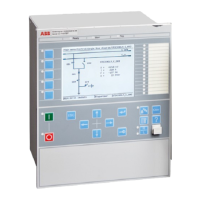min0.5 Load
Base
I
LoadCurr
I
×
=
EQUATION1320 V1 EN-US (Equation 130)
where:
ILoadmin is the minimum load current on the line during normal operation conditions.
The timer
tLoadOn
is used to increase the security of the loss-of-load function for example to
avoid unwanted release due to transient inrush current when energizing the line power
transformer. The loss-of-load function will be released after the timer
tLoadOn
has elapsed at
the same time as the load current in all three phases are above the setting
LoadCurr
. In normal
acceleration applications there is no need for delaying the release, so set the
tLoadOn
to zero.
The drop-out timer
tLoadOff
is used to determine the window for the current release
conditions for Loss-of-load. The timer is by default set to 300ms, which is judged to be
enough to secure the current release.
The setting of the minimum current detector,
MinCurr
, should be set higher than the
unsymmetrical current that might flow on the non faulty line, when the breaker at remote end
has opened (three-phase). At the same time it should be set below the minimum load current
transfer during normal operations that the line can be subjected to. By default,
MinCurr
is set
to 5% of
IBase
.
The pick-up timer
tLowCurr
determine the window needed for pick-up of the minimum current
value used to release the function. The timer is by default set to 200 ms, which is judged to be
enough to avoid unwanted release of the function (avoid unwanted trip).
14.4 Scheme communication logic for residual overcurrent
protection ECPSCH
IP14711-1 v2
14.4.1 Identification
M14882-1 v2
Function description IEC 61850
identification
IEC 60617
identification
ANSI/IEEE C37.2
device number
Scheme communication logic for
residual overcurrent protection
ECPSCH - 85
14.4.2 Application
M13919-3 v5
To achieve fast fault clearance of earth faults on the part of the line not covered by the
instantaneous step of the residual overcurrent protection, the directional residual overcurrent
protection can be supported with a logic that uses communication channels.
One communication channel is used in each direction, which can transmit an on/off signal if
required. The performance and security of this function is directly related to the transmission
channel speed and security against false or lost signals.
In the directional scheme, information of the fault current direction must be transmitted to
the other line end.
1MRK 511 358-UEN A Section 14
Scheme communication
351
Application manual

